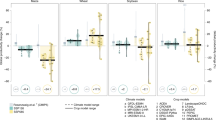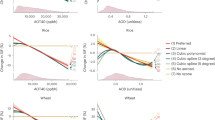Abstract
Stratospheric aerosol intervention (SAI) is a proposed strategy to reduce the effects of anthropogenic climate change. There are many temperature targets that could be chosen for a SAI implementation, which would regionally modify climatically relevant variables such as surface temperature, precipitation, humidity, total solar radiation and diffuse radiation. In this work, we analyse impacts on national maize, rice, soybean and wheat production by looking at output from 11 different SAI scenarios carried out with a fully coupled Earth system model coupled to a crop model. Higher-latitude nations tend to produce the most calories under unabated climate change, while midlatitude nations maximize calories under moderate SAI implementation and equatorial nations produce the most calories from crops under high levels of SAI. Our results highlight the challenges in defining ‘globally optimal’ SAI strategies, even if such definitions are based on just one metric.
This is a preview of subscription content, access via your institution
Access options
Access Nature and 54 other Nature Portfolio journals
Get Nature+, our best-value online-access subscription
$29.99 / 30 days
cancel any time
Subscribe to this journal
Receive 12 digital issues and online access to articles
$119.00 per year
only $9.92 per issue
Buy this article
- Purchase on Springer Link
- Instant access to full article PDF
Prices may be subject to local taxes which are calculated during checkout







Similar content being viewed by others
Data availability
Output from the CESM2(WACCM6) SSP2-4.5 and SSP2-4.5-1.5 °C is freely available at https://doi.org/10.26024/0cs0-ev98. CESM2(WACCM6) output from SSP5-8.5, SSP5-3.4-OS, Geoengineering Model Intercomparison Project G6Solar and G6Sulfur is freely available on Earth System Grid at https://esgf-node.llnl.gov/search/cmip6/. CESM2(WACCM6) output from SSP5-3.4-OS-2.0 °C, SSP5-3.4-OS-1.5 °C and SSP5-8.5-1.5 °C is available at https://doi.org/10.26024/t49k-1016. Coupled and offline CLM5crop postprocessed yield data are available at https://doi.org/10.6084/m9.figshare.24085797.v1. Historical yield observation data were obtained from FAOSTAT at https://www.fao.org/faostat/en/#data.
Code availability
The source code for the CESM(WACCM) model used in this study is freely available at https://www.cesm.ucar.edu/working_groups/Whole-Atmosphere/code-release.html, and the code for CLM5 is available at https://www.cesm.ucar.edu/models/cesm2/land/. Postprocessing and figure generation scripts can be found at https://github.com/bjc204/Clark_etal_NatureFood_2023.
References
Fugile, P. Climate change upsets agriculture. Nat. Clim. Change 11, 293–299 (2021).
Kummu, M., Heino, M., Taka, M., Varis, O. & Viviroli, D. Climate change risks pushing one-third of global food production outside the safe climatic space. One Earth 4, 720–729 (2021).
Rosenzweig, C. et al. Assessing agricultural risks of climate change in the 21st century in a global gridded crop model intercomparison. Proc. Natl Acad. Sci. USA 111, 3268–3273 (2014).
Crutzen, P. J. Albedo enhancement by stratospheric sulfur injections: a contribution to resolve a policy dilemma? Climatic Change 77, 211–220 (2006).
Wigley, T. M. A combined mitigation/geoengineering approach to climate stabilization. Science 314, 452–454 (2006).
National Academies of Sciences, Engineering, and Medicine Reflecting Sunlight: Recommendations for Solar Geoengineering Research and Research Governance (National Academies Press, 2021); https://doi.org/10.17226/25762
Robock, A. 20 reasons why geoengineering may be a bad idea. Bull. At. Sci. 64, 14–18 (2008).
Rasch, P. J., Crutzen, P. J. & Coleman, D. B. Exploring the geoengineering of climate using stratospheric sulfate aerosols: the role of particle size. Geophys. Res. Lett. 35, L02809 (2008).
Jägermeyr, J. et al. Climate impacts on global agriculture emerge earlier in new generation of climate and crop models. Nat. Food 2, 873–885 (2021).
Farquhar, G., Caemmerer, S. & Berry, J. A biochemical model of photosynthetic CO2 assimilation in leaves of C3 species. Planta 149, 78–90 (1980).
Collatz, G. J., Ribas-Carbo, M. & Berry, J. A. Coupled photosynthesis–stomatal conductance model for leaves of C4 plants. Funct. Plant Biol. 19, 519–538 (1992).
Bala, G., Duffy, P. B. & Taylor, K. E. Impact of geoengineering schemes on the global hydrological cycle. Proc. Natl Acad. Sci. USA 105, 7664–7669 (2008).
Proctor, J. et al. Estimating global agricultural effects of geoengineering using volcanic eruptions. Nature 560, 480–483 (2018).
Pongratz, J., Lobell, D. B., Cao, L. & Caldeira, K. Crop yields in a geoengineered climate. Nat. Clim. Change 2, 101–105 (2012).
Xia, L. et al. Solar radiation management impacts on agriculture in China: a case study in the Geoengineering Model Intercomparison Project (GeoMIP). J. Geophys. Res. Atmos. 119, 8695–8711 (2014).
Zhan, P. et al. Impacts of sulfate geoengineering on rice yield in China: results from a multimodel ensemble. Earth’s Future 7, 395–410 (2019).
Fan, Y. et al. Solar geoengineering can alleviate climate change pressures on crop yields. Nat. Food 2, 373–381 (2021).
Tilmes, S. et al. Reaching 1.5 and 2.0 °C global surface temperature targets using stratospheric aerosol geoengineering. Earth Syst. Dynam. 11, 579–601 (2020).
Richter, J. et al. Assessing responses and impacts of solar climate intervention on the Earth system with stratospheric aerosol injection (ARISE-SAI): protocol and initial results from the first simulations. Geosci. Model Dev. 15, 8221–8243 (2022).
MacMartin, D. et al. Scenarios for modeling solar radiation modification. Proc. Natl Acad. Sci. USA 119, e2202230119 (2022).
Tilmes, S. et al. CESM1(WACCM) Stratospheric Aerosol Geoengineering Large Ensemble Project. Bull. Am. Meteorol. Soc. 99, 2361–2371 (2018).
Dagon, K. & Schrag, D. P. Quantifying the effects of solar geoengineering on vegetation. Climatic Change 153, 235–251 (2019).
Kravitz, B. et al. The Geoengineering Model Intercomparison Project Phase 6 (GeoMIP6): simulation design and preliminary results. Geosci. Model Dev. 8, 3379–3392 (2015).
Danabasoglu, G. et al. The Community Earth System Model Version 2 (CESM2). J. Adv. Model. Earth Syst. 12, e2019MS001916 (2020).
Lombardozzi, D. L. et al. Simulating agriculture in the Community Land Model Version 5. J. Geophys. Res. Biogeosci. 125, e2019JG005529 (2020).
Lawrence, D. M. et al. The Community Land Model version 5: description of new features, benchmarking, and impact of forcing uncertainty. J. Adv. Model. Earth Syst. 11, 4245–4287 (2019).
Fisher, R. et al. Parametric controls on vegetation responses to biogeochemical forcing in the CLM5. J. Adv. Model. Earth Syst. 11, 2879–2895 (2019).
Dirmeyer, P. A. et al. GSWP-2: multimodel analysis and implications for our perception of the land surface. Bull. Am. Meteorol. Soc. 87, 1381–1398 (2006).
Rabin, S. S., Sacks, W. J., Lombardozzi, D. L., Xia, L. & Robock, A. Observation-based sowing dates and cultivars significantly affect yield and irrigation for some crops in the Community Land Model (CLM5). Preprint at Geoscientific Model Development https://doi.org/10.5194/gmd-2023-66 (2023).
Food Balance Spreadsheets (FAO, accessed 20 July 2022); https://www.fao.org/faostat/en/#data/FBS
Müller, C. et al. Global gridded crop model evaluation: benchmarking, skills, deficiencies and implications. Geosci. Model Dev. 10, 1403–1422 (2017).
Proctor, J. Atmospheric opacity has a nonlinear effect on global crop yields. Nat. Food 2, 166–173 (2021).
Reynolds, J. L. Solar geoengineering to reduce climate change: a review of governance proposals. Proc. R. Soc. A https://doi.org/10.1098/rspa.2019.0255 (2019).
Svoboda, T. & Irvine, P. Ethical and technical challenges in compensating for harm due to solar radiation management geoengineering. Ethics Policy Environ. 17, 157–174 (2014).
Bunzl, M. Geoengineering harms and compensation. Stanf. J. Law Sci. Policy 4, 69–75 (2019).
Gettelman, A. et al. The Whole Atmosphere Community Climate Model version 6 (WACCM6). J. Geophys. Res. Atmos. 124, 12380–12403 (2019).
Liu, X. et al. Description and evaluation of a new four-mode version of the Modal Aerosol Module (MAM4) within version 5.3 of the Community Atmosphere Model. Geosci. Model Dev. 9, 505–522 (2016).
O’Neill et al. The Scenario Model Intercomparison Project (ScenarioMIP) for CMIP6. Geosci. Model Dev. 9, 3461–3482 (2016).
United Nations Framework Convention on Climate Change (UN General Assembly, 2015); https://unfccc.int/sites/default/files/english_paris_agreement.pdf
IPCC Climate Change 2021: The Physical Science Basis (eds Masson-Delmotte, V. et al.) (Cambridge Univ. Press, 2021).
Kravitz, B. et al. First simulations of designing stratospheric sulfate aerosol geoengineering to meet multiple simultaneous climate objectives. J. Geophys. Res. Atmos. 122, 12,616–12,634 (2017).
Davis, N. A. et al. Climate, variability, and climate sensitivity of ‘Middle Atmosphere’ chemistry configurations of the Community Earth System Model Version 2, Whole Atmosphere Community Climate Model Version 6 (CESM2(WACCM6)). Preprint at Authorea https://doi.org/10.22541/essoar.167117634.40175082/v1 (2022).
Visioni, D. et al. Identifying the sources of uncertainty in climate model simulations of solar radiation modification with the G6sulfur and G6solar Geoengineering Model Intercomparison Project (GeoMIP) simulations. Atmos. Chem. Phys. 21, 10039–10063 (2021).
Acknowledgements
This work was supported by NSF grant nos. AGS-2017113 and ENG-2028541 awarded to A.R. and L.X. and by a gift from SilverLining’s Safe Climate Research Initiative. This material is based on work supported by the National Center for Atmospheric Research, which is a major facility sponsored by the NSF under cooperative agreement no. 1852977. Computing and data storage resources, including the Cheyenne supercomputer (https://doi.org/10.5065/D6RX99HX), were provided by the Computational and Information Systems Laboratory at the National Center for Atmospheric Research. We thank H. Stephens for developing the yield conversion script.
Author information
Authors and Affiliations
Contributions
B.C., L.X. and A.R. designed the study. S.T., J.H.R. and D.V. conducted the climate model simulations. B.C., S.S.R. and L.X. conducted the offline crop model simulations. B.C. analysed the data with contributions from all the authors. B.C., L.X. and A.R. wrote the first draft, and all authors contributed to editing and revising the paper.
Corresponding author
Ethics declarations
Competing interests
The authors declare no competing interests.
Peer review
Peer review information
Nature Food thanks the anonymous reviewers for their contribution to the peer review of this work.
Additional information
Publisher’s note Springer Nature remains neutral with regard to jurisdictional claims in published maps and institutional affiliations.
Supplementary information
Supplementary Information
Supplementary Figs. 1–12.
Rights and permissions
Springer Nature or its licensor (e.g. a society or other partner) holds exclusive rights to this article under a publishing agreement with the author(s) or other rightsholder(s); author self-archiving of the accepted manuscript version of this article is solely governed by the terms of such publishing agreement and applicable law.
About this article
Cite this article
Clark, B., Xia, L., Robock, A. et al. Optimal climate intervention scenarios for crop production vary by nation. Nat Food 4, 902–911 (2023). https://doi.org/10.1038/s43016-023-00853-3
Received:
Accepted:
Published:
Issue Date:
DOI: https://doi.org/10.1038/s43016-023-00853-3
This article is cited by
-
Unequal effects of climate intervention on agriculture
Nature Food (2023)



